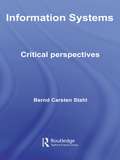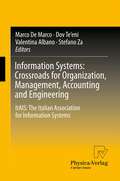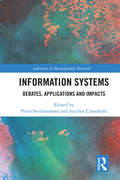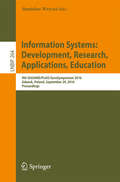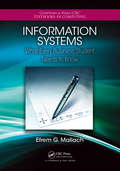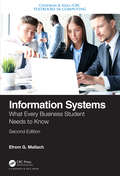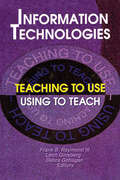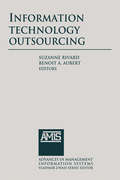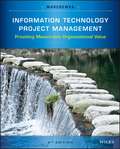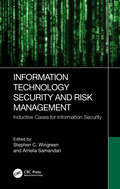- Table View
- List View
Information Systems: A Manager's Guide to Harnessing Technology version 1.2
by John GallaugherInformation Systems: A Manager's Guide to Harnessing Technology V1.2 is intended for use in undergraduate and/or graduate courses in Management Information Systems and Information Technology. Version 1.2 of John's book retains the same structure and theory of version 1.1, but refreshes key statistics, examples, and brings case material up to date (vital when covering firms that move as fast as Facebook, Google, and Netflix). Adopting version 1.2 guarantees your students will have the most current text on the market, drawing real and applicable lessons from material that will keep your class offerings current and accessible.
Information Systems: A Manager's Guide to Harnessing Technology version 1.3
by John GallaugherInformation Systems: A Manager's Guide to Harnessing Technology V 1.3 is intended for use in undergraduate and/or graduate courses in Management Information Systems and Information Technology. Version 1.3 of John's book retains the same structure and theory of version 1.1 and V 1.2, but refreshes key statistics, examples, and brings case material up to date (vital when covering firms that move as fast as Facebook, Google, and Netflix). For example; the Netflix chapter - Updates address the major changes impacting Netflix in 2011, including the response to the firm's pricing changes, the failed Qwikster service split, recent developments impacting the streaming and DVD-by-mail businesses, a comparison table detailing the stark differences between the firm's two offerings (DVD & streaming), updated statistics, learning objectives, and additional exercises and updates to the Google chapter - Updated text/images for currency, additional sub-sections on the firm's Google+ launch and the acquisition of Motorola Mobility. Adopting version 1.3 guarantees your students will have the most current text on the market, drawing real and applicable lessons from material that will keep your class offerings current and accessible.
Information Systems: A Manager's Guide to Harnessing Technology version 1.4
by John GallaugherInformation Systems: A Manager’s Guide to Harnessing Technology V 1.4 is intended for use in undergraduate and/or graduate courses in Management Information Systems and Information Technology. Version 1.4 of John's book retains the same structure and theory of the earlier versions, but Version 1.4 updates key statistics and examples, and includes up-to-date case material, such as Pinterest and Facebook’s Instagram acquisition. Adopting version 1.4 guarantees your students will have the most current text on the market, drawing real and applicable lessons from material that will keep your class offerings current and accessible.
Information Systems: A Manager's Guide to Harnessing Technology, Version 3.0
by John GallaugherWHAT'S NEW IN 3.0:<P><P> UPDATED, MORE RELEVANT INFORMATION:<P> New coverage including Uber, WhatsApp, Facebook, and bitcoin breathes fresh life into existing material. The popular Zara and Netflix case studies remain but contain refreshed information.<P> EMPHASIS ON SOCIAL MEDIA:<P> Instagram, SnapChat, WhatsApp, Tinder, Secret, and Whisper all receive mention, ensuring relevancy and proper understanding of the current field.<P> MOBILE VS. DESKTOP:<P> In a number of renamed chapters, Gallaugher weighs the pros and cons of social media use on desktop computers and mobile devices, prompting classroom dialogue surrounding the rise of different technologies and how businesses and managers adjust to emerging trends.<P> DISCUSSION OF THE SHARING ECONOMY:<P> With the addition of an entirely new chapter focused on the sharing economy, Gallaugher introduces examples of citizens coming together to create or share resources across markets.<P> For a comprehensive list of what's new in version 3.0, visit Gallaugher’s blog.<P> John Gallaugher of Boston College was one of BusinessWeek’s “Professors of the Year.” His widely popular textbook offers a proven approach that has garnered student praise and increased information systems enrollment. There is no other Information Systems author today who keeps his text as "up-to-the-month" current. <P> For regular updates, follow Gallaugher’s blog, The Week in Geek, and connect with him on Twitter at @gallaugher.<P> This textbook is suitable for these courses:Undergraduate or graduate courses in Management Information Systems and Information Technology<P> This textbook is suitable for 2 and 4 year institutions.<P> PEDAGOGICAL FEATURES:<P> FOCUS ON STRATEGIC THINKING:<P> Rather than lead with technical topics, the book starts with strategic thinking, focusing on big-picture issues that have confounded experts but will engage students.<P> ENGAGING CASE STUDIES:<P> While chapters introduce concepts, cases on approachable, exciting firms across industries further challenge students to apply what they've learned.<P> CUSTOMIZABILITY:<P> The Flat World Knowledge publishing model allows instructors to adapt the textbook to the exact needs of their specific class and student body. <P>
Information Systems: A Manager's Guide to Harnessing Technology, v. 5.0
by John GallaugherWHAT'S NEW IN 5.0:<P><P> FRESHLY UPDATED:<P> Every chapter has received an update to ensure that it covers the latest topics and material. Today’s cutting edge firms and headline grabbing topics are presented through durable frameworks and concepts.<P> WORLDWIDE TRENDS IN TECH DEVELOPMENTS:<P> Included are updates and statistics on companies and technologies being developed around the world. China started the century as a nation largely unplugged and offline, but now has more internet users than any other country. In Sub-Saharan Africa, 70% of the population lives within mobile cell phone coverage. Now, even drones are affordable enough to be used as a delivery system in places with poor infrastructure.<P> PROTEUS, A PILL CAMERA:<P> A mini-case in the “Moore’s Law and More” chapter discusses the launch of Proteus’s low cost and efficient “PillCam.” Using small sensors and powered by digestive acids, the pill allows doctors to see a unique perspective inside the human body (literally).<P> SOCIAL MEDIA POWERHOUSE:<P> Statistics on the massive amount of new social networks and acquisitions in the marketplace have all been updated. New content includes Microsoft’s acquisition of LinkedIn, Slack’s dominant presence in the business space, and the rise of companies like HubSpot. New subsections discuss Twitter and the rise of microblogging, as well as Facebook’s dominant news feed and its strong position against Google’s advertising monopoly.<P> CUTTING EDGE COVERAGE:<P> From Facebook’s move to make Messenger a platform to Google’s evolution to Alphabet, students will feel their text and classroom are alive with the most current content available.<P> For a comprehensive list of what's new in version 5.0, visit Gallaugher’s blog.<P> John Gallaugher of Boston College has been named one of Entrepreneur Magazine’s “Gurus to Grads.” His popular and award-winning textbook offers a proven approach that has garnered student praise and increased information systems enrollment. Each year Gallaugher meets with scores of tech industry executives from Silicon Valley to sub-Saharan Africa, and there is no other Information Systems author today who keeps his text as "up-to-the-month" current. <P> For regular updates, follow Gallaugher’s blog, The Week in Geek, and connect with him on Twitter at @gallaugher.<P> This textbook is suitable for these courses:Undergraduate or graduate courses in Management Information Systems and Information Technology<P> This textbook is suitable for 2 and 4 year institutions.<P> PEDAGOGICAL FEATURES:<P> FOCUS ON STRATEGIC THINKING:<P> Rather than lead with technical topics, the book starts with strategic thinking, focusing on big-picture issues that have confounded experts but will engage students.<P> CURRENT, ENGAGING AND HOLISTIC CASE STUDIES:<P> While chapters introduce concepts, cases on approachable, exciting firms across industries further challenge students to apply what they've learned. Students love how concepts are introduced in a text that reads more like Wired and the Wall Street Journal than a conventional textbook.<P> CONCEPTS:<P> Chapters cover not only strategy and technology basics, but critical and cutting edge concepts such as data analytics, security, social media, the sharing economy, disruptive innovation, network effects and platform creation, open source, and cloud computing.<P> FASCINATING FIRMS:<P> In-depth profiles include firms that students know and are eager to learn more about. Amazon, Facebook, Google, Netflix, Rent the Runway, and Zara are among the firms that get extended coverage, along with mini-cases on Airbnb, Uber, and more.<P> CUSTOMIZABILITY:<P> The Flat World Knowledge publishing model allows instructors to adapt the textbook to the exact needs of their specific class and student body. See how easy it is to customize a textbook in this 4 minute demo: Flat World Editing Platform Video Demo
Information Systems: A Manager’s Guide to Harnessing Technology
by John GallaugherThe text offers a proven approach that has garnered student praise, increased IS enrollment, and engaged students to think deeper and more practically about the space where business and technology meet. Every topic is related to specific business examples, so students gain an immediate appreciation of its importance. Rather than lead with technical topics, the book starts with strategic thinking, focusing on big-picture issues that have confounded experts but will engage students. And while chapters introduce concepts, cases on approachable, exciting firms across industries further challenge students to apply what they've learned, asking questions like: Why was NetFlix able to repel Blockbuster and WalMart? How did Harrah's Casino's become twice as profitable as comparably-sized Caesar's, enabling the former to acquire the latter? How does Spain's fashion giant Zara, a firm that shuns the sort of offshore manufacturing used by every other popular clothing chain, offer cheap fashions that fly off the shelves, all while achieving growth rates and profit margins that put Gap to shame? What's an IPO and can a technology alternative push out investment bankers and insiders to the benefit of entrepreneurs and small investors? Why is Google more profitable than Disney? Is Facebook really worth $15 billion?
Information Systems: Critical Perspectives (Routledge Studies In Organization And Systems Ser.)
by Bernd Carsten StahlWhilst Information Systems has the potential to widen our view of the world, it often has the opposite effect by limiting our ability to interact, facilitating managerial and state surveillance or instituting strict hierarchies and personal control. In this book, Bernd Stahl offers an alternative and critical perspective on the subject, arguing tha
Information Systems: Crossroads for Organization, Management, Accounting and Engineering
by Stefano Za Marco De Marco Dov Te'Eni Valentina AlbanoThis book examines a wide range of issues that characterize the current IT based innovation trends in organizations. It contains a collection of research papers focusing on themes of growing interest in the field of Information Systems, Organization Studies, Management, Accounting and Engineering. The book offers a multidisciplinary view on Information Systems with the aim of disseminating academic knowledge. It would be particularly relevant to IT practitioners such as information systems managers and IT consultants. The 12 sections cover a broad spectrum of topics including: eServices in Public and Private Sectors; Organizational Change and the Impact of ICT in Public and Private Sectors; Information and Knowledge Management; Human-Computer Interaction; Information Systems, Innovation Transfer, and New Business Models; Business Intelligence Systems, their Strategic Role and Organizational Impacts; New Ways to Work and Interact with the Internet; IS, IT and Security; Blending Design and Behavioral Research in Information Systems; Professional Skills, Certification of Curricula, Online Education and Communities; IS Design, IS Development, Metrics and Compliance; ICT4LAW: Information and communication technologies to help firms, public administrations, legislators and citizens to operate in a highly regulated world. The content of each section is based on a selection of original double-blind peer reviewed contributions.
Information Systems: Debates, Applications and Impacts
by Jocelyn Cranefield Priya SeetharamanThis book captures a range of important developments that have occurred in Information Systems over the last forty years, with a particular focus on India and the developing world. Over this time, Information and Communications Technology (ICT) and Information Systems (IS) have come to play a critical role in supporting, complementing and automating managerial decisions, shaping and transforming industries, and contributing to deep societal and economic change. This volume examines a range of topics for those interested in the adoption and use of these technologies across varied situations. It combines empirical studies on the application and impact of IS with commentaries, debates and insights on the transformative role that IT and the IT industry have played, and continue to play, within India as well as globally. The book draws attention to issues and challenges that organizations grapple with in tech-enabled environments, and provides insights on the role of automation and computational techniques. It explores the global impact of the technology revolution on economic growth and development, electronic globalization, and the wider opportunities and challenges of a hi-tech world. The chapters cover various themes such as e-government in India, internet-based distribution systems, internet banking, and use of collaborative IT tools and functions to support virtual teams in the software industry and the business process outsourcing industry. Other chapters focus on methodological advances, such as systems thinking which finds applications in organizational decision-making, and the use of fuzzy logic. This volume will interest professionals and scholars of information technology and information systems, computer studies, IT systems, economics, and business and management studies.
Information Systems: Development, Research, Applications, Education
by Stanislaw WryczaThis book constitutes the refereed proceedings of the SIGSAND/PLAIS EuroSymposium 2016 titled Information Systems: Development, Research, Applications, Education, held in Gdansk and Sopot, Poland, on September 29, 2016. The objective of this symposium is to promote and develop high-quality research on all issues related to systems analysis and design (SAND). It provides a forum for SAND researchers and practitioners in Europe and beyond to interact, collaborate, and develop their field. The 14 papers presented in this volume were carefully reviewed and selected from 34 submissions. They are organized in topical sections on information systems development, information systems management, and information systems learning.
Information Systems: What Every Business Student Needs to Know (Chapman & Hall/CRC Textbooks in Computing)
by Efrem G. MallachMost information systems (IS) texts overwhelm business students with overly technical information they may not need in their careers. This textbook takes a new approach to the required IS course for business majors. For each topic covered, the text highlights key "Take-Aways" that alert students to material they will need to remember during their careers. Sections titled "Where You Fit In" and "Why This Chapter Matters" explain how the topics being covered will impact students once they are on the job. Review questions, discussion questions, and summaries are included in each chapter.
Information Systems: What Every Business Student Needs to Know, Second Edition (Chapman & Hall/CRC Textbooks in Computing)
by Efrem G. MallachMost information systems textbooks overwhelm business students with overly technical information they may not need in their careers. This textbook takes a new approach to the required information systems course for business majors. For each topic covered, the text highlights key "Take-Aways" that alert students to material they will need to remember during their careers. Sections titled "Where You Fit In" and "Why This Chapter Matters" explain how the topics being covered will impact students on the job. Review questions, discussion questions, and summaries are also included. This second edition is updated to include new technology, along with a new running case study. Key features: Single-mindedly for business students who are not technical specialists Doesn&’t try to prepare IS professionals; other courses will do that Stresses the enabling technologies and application areas that matter the most today Based on the author&’s real-world experience Up to date regarding technology and tomorrow&’s business needs This is the book the author—and, more importantly, his students—wishes he had when he started teaching. Dr. Mallach holds degrees in engineering from Princeton and MIT, and in business from Boston University. He worked in the computer industry for two decades, as Director of Strategic Planning for a major computer firm and as co-founder/CEO of a computer marketing consulting firm. He taught information systems in the University of Massachusetts (Lowell and Dartmouth) business schools for 18 years, then at Rhode Island College following his retirement. He consults in industry and serves as Webmaster for his community, in between hiking and travel with his wife.
Information Technologies: Teaching to Use—Using to Teach
by Leon Ginsberg Frank B Raymond Iii Debra GohaganThis insightful volume explores examples of the use of technology to teach social work knowledge, values, and skills across the curriculum. The chapters cover a wide range of perspectives, including international views of the role of information technology in Great Britain and Malaysia, training approaches for faculty development, and computer-based software that has the potential to transform the manner in which curriculum objectives are met. Prepare for technology-based instruction in social work education for the 21st century!Information Technologies: Teaching to Use--Using to Teach Information Technologies: Teaching to Use--Using to Teach, addresses your need to fully prepare today?s social work graduates to work and live in this rapidly changing, technology-enhanced environment. Based on the 1997 Information Technologies Conference: Using to Teach--Teaching to Use, held in Charleston, South Carolina, this book covers the multitude of topics that were presented on technology-based instruction as we head into the 21st century. Articles in Information Technologies range from the use of the Internet and computer applications to research projects that address the effectiveness of technology-based teaching and learning activities. It also dicusses international views on the role of information technology in Britian and Malaysia. Information Technologies gives particular attention to distance education, and it is the most thorough treatment to date of the use and teaching of technology in social work education. Specific areas you?ll gain valuable information from include:establishing a faculty development labstarting intensive faculty training sessionscomputer-based software that has the potential to transform the manner in which curriculum objectives are metinternational perspectives on information technologythe use of Geographic Information Systems technology in social work practice as a tool for improved visualization of social and economic inequalitiesmodels for teaching social work curriculum with technologyWith Information Technologies, you will gain a competetive edge in preparing your faculty and students with the latest world-wide information on studies pretaining to technology use in a social work setting. A conglomeration of diverse and well-researched articles on the use of technology to enhance social work education await you in this special volume.
Information Technology
by Indian Institute of Banking FinanceThe book covers in detail the essential topics under Information Technology which is very required for banking aspirants and also intends to be useful for anybody interested in banking including students, academics and researchers.
Information Technology Control and Audit, Fifth Edition
by Angel R. OteroThe new fifth edition of Information Technology Control and Audit has been significantly revised to include a comprehensive overview of the IT environment, including revolutionizing technologies, legislation, audit process, governance, strategy, and outsourcing, among others. This new edition also outlines common IT audit risks, procedures, and involvement associated with major IT audit areas. It further provides cases featuring practical IT audit scenarios, as well as sample documentation to design and perform actual IT audit work. Filled with up-to-date audit concepts, tools, techniques, and references for further reading, this revised edition promotes the mastery of concepts, as well as the effective implementation and assessment of IT controls by organizations and auditors.
Information Technology Outsourcing (Advances In Management Information Systems Ser.)
by Suzanne Rivard Benoit A. AubertThis new volume in the "Advances in Management Information Systems" series presents the latest cutting-edge knowledge in IT outsourcing. As part of the growing business trend to outsourcing various operations, IT outsourcing both determines the governance of a vital organizational function and influences the processes of exploitation and exploration in all other functions of an enterprise. In keeping with the mission of the "AMIS" series, the editors of this volume have framed the domain of research and practice broadly. "Information Technology Outsourcing" provides leading edge research on both the variety of decisions regarding the outsourcing of IS services and the management of the relationship with service suppliers.
Information Technology Project Management: Providing Measurable Organizational Value
by Jack MarchewkaThe 5th Edition of Jack Marchewka's Information Technology Project Management focuses on how to create measurable organizational value (MOV) through IT projects. The author uses the concept of MOV, combined with his own research, to create a solid foundation for making decisions throughout the project's lifecycle. <p><p> The book's integration of project management and IT concepts provides students with the tools and techniques they need to develop in this field.
Information Technology Security and Risk Management: Inductive Cases for Information Security
by Stephen C. Wingreen Amelia SamandariInformation Technology Security and Risk Management: Inductive Cases for Information Security is a compilation of cases that examine recent developments and issues that are relevant to IT security managers, risk assessment and management, and the broader topic of IT security in the 21st century. As the title indicates, the cases are written and analyzed inductively, which is to say that the authors allowed the cases to speak for themselves, and lead where they would, rather than approach the cases with presuppositions or assumptions regarding what the case should be "about". In other words, the authors were given broad discretion to interpret a case in the most interesting and relevant manner possible; any given case may be "about" many things, depending on the perspective adopted by the reader, and many different lessons may be learned. The inductive approach of these cases reflects the design philosophy of the advanced IT Security and Risk Management course we teach on the topic here at the University of Canterbury, where all discussions begin with the analysis of a specific case of interest and follow the most interesting and salient aspects of the case in evidence. In our course, the presentation, analysis, and discussion of a case are followed by a brief lecture to address the conceptual, theoretical, and scholarly dimensions arising from the case. The inductive approach to teaching and learning also comes with a huge advantage – the students seem to love it, and often express their appreciation for a fresh and engaging approach to learning the sometimes-highly-technical content of an IT security course. As instructors, we are also grateful for the break in the typical scripted "chalk-and-talk" of a university lecture afforded by the spontaneity of the inductive approach.We were motivated to prepare this text because there seems to be no other book of cases dedicated to the topic of IT security and risk management, and because of our own success and satisfaction with inductive teaching and learning. We believe this book would be useful either for an inductive, case-based course like our own or as a body of cases to be discussed in a more traditional course with a deductive approach. There are abstracts and keywords for each case, which would help instructors select cases for discussions on specific topics, and PowerPoint slides are available as a guide for discussion about a given case.
Information Technology System That Couldn't Deliver (HBR Case Study and Commentary)
by John King Thornton May Robert A. Distefano James K. Sims Richard Nolan Byron ReimusDiana Sullivan, CEO of Lenox Insurance, thought she had done her job when, after three years of hard work, she had delivered Lifexpress on time and on budget. A sophisticated computer-aided system, it enabled Lenox's 10,000-plus agents to do everything from establish a prospect's financial profile, to select the most appropriate products from the company's myriad policies, to generate all the paperwork needed to close a sale. But now Sullivan's boss, CFO Clay Fontana, seemed to be holding her accountable not only for the creation and implementation of the system but for realizing its business goals as well. And Lenox's CEO, James Bennett, appeared to concur. In this hypothetical case study, Sullivan and the other top executives at Lenox must decide who should be responsible for realizing the business goals of information technology projects. Should Sullivan have gone about the project in another way? Should Fontana and Bennett be playing more active roles? In 97308 and 97308Z, commentators James K. Sims, Thornton May, Richard Nolan, Robert A. Distefano, and John King offer advice on this fictional case study.
Information Technology and Clinical Operations at Beth Israel Deaconess Medical Center
by F. Warren Mcfarlan Richard BohmerDescribes the history of clinical computing at Boston's Beth Israel Hospital and the development, since the 1996 merger to form the Beth Israel Deaconess Medical Center, of an information system designed to support the delivery of patient care. The hospitals' CIO, John Halamka, MD, has overseen the development of an information system that places physicians at its center. Describes the design and function of five major components of the system: the On-Line Medical Record, ePrescribing, Physician Order Entry, the Emergency Department "dashboard," and the Performance Manager. Provides students with an opportunity to identify key design principles for health care information systems, and to discuss the unique implementation challenges that the health care delivery setting raises for CIOs and CEOs.
Information Technology and Competitive Advantage in Small Firms (Routledge Studies In Small Business Ser. #Vol. 13)
by Brian Webb Frank SchlemmerDoes Information Technology matter? This book argues that even as Information Technology hardware, software, data and associated processes are becoming more of a commodity, it has never been more important to manage Information Technology as a strategic asset. However, managing Information Technology as a strategic asset is notoriously difficult, a
Information Technology and Data in Healthcare: Using and Understanding Data (HIMSS Book Series)
by David HartzbandHealthcare transformation requires us to continually look at new and better ways to manage insights – both within and outside the organization. Increasingly, the ability to glean and operationalize new insights efficiently as a byproduct of an organization’s day-to-day operations is becoming vital for hospitals and health systems to survive and prosper. One of the long-standing challenges in healthcare informatics has been the ability to deal with the sheer variety and volume of disparate healthcare data and the increasing need to derive veracity and value out of it. This book addresses several topics important to the understanding and use of data in healthcare. First, it provides a formal explanation based on epistemology (theory of knowledge) of what data actually is, what we can know about it, and how we can reason with it. The culture of data is also covered and where it fits into healthcare. Then, data quality is addressed, with a historical appreciation, as well as new concepts and insights derived from the author’s 35 years of experience in technology. The author provides a description of what healthcare data analysis is and how it is changing in the era of abundant data. Just as important is the topic of infrastructure and how it provides capability for data use. The book also describes how healthcare information infrastructure needs to change in order to meet current and future needs. The topics of artificial intelligence (AI) and machine learning in healthcare are also addressed. The author concludes with thoughts on the evolution of the role and use of data and information going into the future.
Information Technology and Development: A New Paradigm for Delivering the Internet to Rural Areas in Developing Countries (Routledge Studies In Development Economics Ser. #Vol. 39)
by Jeffrey JamesAttempts to bring the benefits of information technology in the form of the internet to developing countries have, to date, foundered on the belief that this requires the beneficiaries to access the technology directly. As a result, the perceived huge benefits of such an enterprise have often failed to materialise.This original contribution to the
Information Technology and Industrial Policy (Routledge Library Editions: The Economics and Business of Technology #20)
by Jill HillsPublished in 1984, this book reviews British industrial policy towards information technology within the context of the international trading system. It argues that the incoherence of British policy stems from the clash between its core liberal ideology and its centralised political system and that unless Britiain's traditional liberal ideology in trade policy was abandoned within this market, Britiain was set to become a mere technological dependency of America. It discusses how the British government needed to develop effective non-tariff barriers in the form of 'industrial policy' to minimise the political and economic costs of technological dependence.
Information Technology and Innovation Trends in Organizations
by Paolo Spagnoletti Joey F. George Maria Ferrara Alessandro D'AtriThe book examines a wide range of issues that characterize the current IT based innovation trends in organisations. It contains a collection of research papers focusing on themes of growing interest in the field of Information System, Organization Studies, and Management. The book offers a multi-disciplinary view on Information Systems aiming to disseminate academic knowledge. It might be particularly relevant to IT practitioners such as information systems managers, business managers and IT consultants. The volume is divided into XIV sections, each one focusing on a specific theme. A preface written by Joey George, president of the Association for Information Systems opens the text. The content of each section is based on a selection of the best papers (original double blind peer reviewed contributions) presented at the annual conference of the Italian chapter of AIS, which has been held in Naples, Italy, on October 2010.

